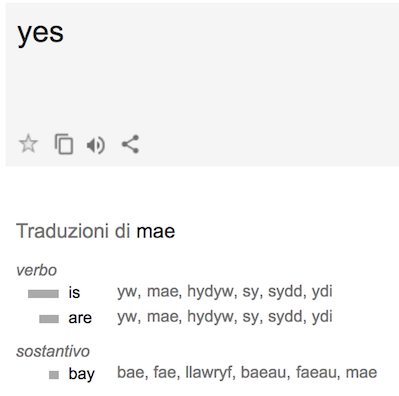The thing is, the verb ‘to be’ in Welsh is complicated, especially (oddly) in the third person singular – he/she is – where it makes a number of distinctions between different patterns of sentences that neither English nor Italian mark in any way. I think if you try to learn them separately, you’ll find you’re too busy thinking in Italian and translating to actually wind up speaking Welsh, so it’s probably best to persevere with the challenges and the Slack, and slowly (hopefully) more of those confident, automatic, someone-else-speaking chunks will fit into place in your own sentences. Then when you get stuck, or get curious about “well why is it sydd and not mae in this sentence” you’ll be in a better position to look stuff up (say, in Gareth’s grammar) and have it make sense.
But for now: sydd (or sy’n, which is short for sydd yn, if it needs an yn after it) is basically a special form for “which is”, to use in relative clauses – like meeting someone who knows your sister (sy’n nabod dy chwaer). However, it also gets used in other places, too – like French asking “what is it that is” (qu’est-ce que c’est instead of just ‘what is it’) or Portuguese (o que é que é), Welsh asks “Who [is it] that is here?” and answers “[It is] me who is here” – Pwy sy’ 'ma? Fi sy’ 'ma.
In other sentences you get different forms depending if you’re saying something exists (c’è), or identifying what someone or something is, or just describing them. And the details of all this are things I’m still trying to get right. But I think that if you’re talking to a native speaker and you use mae where you should have used ydy, say, the person you’re speaking to will understand you, and remember the fact that you chose to speak Welsh to them, long after they’ve forgotten that mae.
Putting it all together, you’ve got something like this:
Is there someone at the door? Yes.
C’è qualcuno alla porta? Sì.
Oes rhywun wrth y drws? Oes. (You’ll hear this when Aran asks “Do you have children?”)
Who is there?
Chi è là?
Pwy sydd yno? (You’ll hear this when you talk about meeting someone who knows your sister.)
Edward is at the door.
Edward è alla porta.
Mae Edward wrth y drws. (This is the normal one you’ll hear all the time.)
Edward is the doctor.
Edward è il dottore.
Edward ydy’r meddyg. (This is only in certain kinds of sentences, but you will hear it in SSiW.)
In all of those the Italian and English are the same, and the Welsh is different: but the best way to get the Welsh to stick in your head and come out at the right time is to keep letting that ‘someone’ say all the right things for you in the Challenges, until you find yourself doing it naturally on Slack.
![]()
![]()





